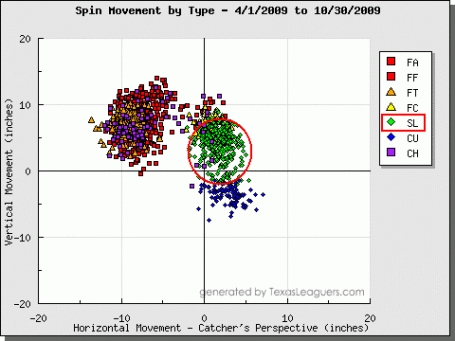Sticking mostly with his two-seam fastball with sink action, Blackburn tested the integrity of Target Field’s sod all night long. Assisted by an infield slowed by rain, 19 of the 21 waterlogged grounders were converted to outs. Despite working through the lineup proficiently and using only 94 pitches, Blackburn was seemingly flirting with disaster right up until J.J. Hardy’s game-saving defensive decision as 11 other batted balls became hits.
After the game, Blackburn told LaVelle E Neal that he “threw just a handful of sliders because his slider wasn’t very sharp.” Not only was the slider apparently lacking bite on Tuesday, but it has been missing all season. According to the pitch f/x mapping over the past two years, there is a pitch that is noticeably absent in his repertoire:


What these two charts indicate is that Blackburn is no longer throwing his slider. As a pitcher that relies heavily on movement and command, losing one bullet in his arsenal is potentially problematic. In 2009, Blackburn was in the bottom five in the categories of Swinging Strikes, Contact Rate and Balls in Play. This season, Blackburn is the lowest among all qualified starters across the board:
Blackburn’s pitch results | Swing Strike% | Contact% | Balls in Play% |
Average | 14% | 80% | 30% |
2009 | 9% | 87% | 37% |
2010 | 4% | 94% | 43% |
The natural assumption is that the decline in these marks is a direct correlation to his discarded slider. And that would be fairly accurate. In 2009, Blackburn’s slider - with a 10% whiff rate - was his pitch most likely to receive a swing-and-miss. This season he has been filling this void with more hittable fastballs and changeups thus the higher contact totals.
Blackburn has always been the socialist pitcher who regularly redistributes the outs to his fellow defenders yet his strikeouts per 9 innings has fallen from the concerning 4.29 in ’09 to a spit-takingly low 2.48 in ’10. Although he is not anything remotely similar to a strikeout pitcher (a career 4.4 K/9 coming into this season), Blackburn still needs to maintain some level of respectability in this department. More balls put between the chalk lines also creates more opportunities for hits, which is a nasty precursor for runs. Reestablishing his slider could help elevate his strikeout total and reduce the amount of balls in play.
